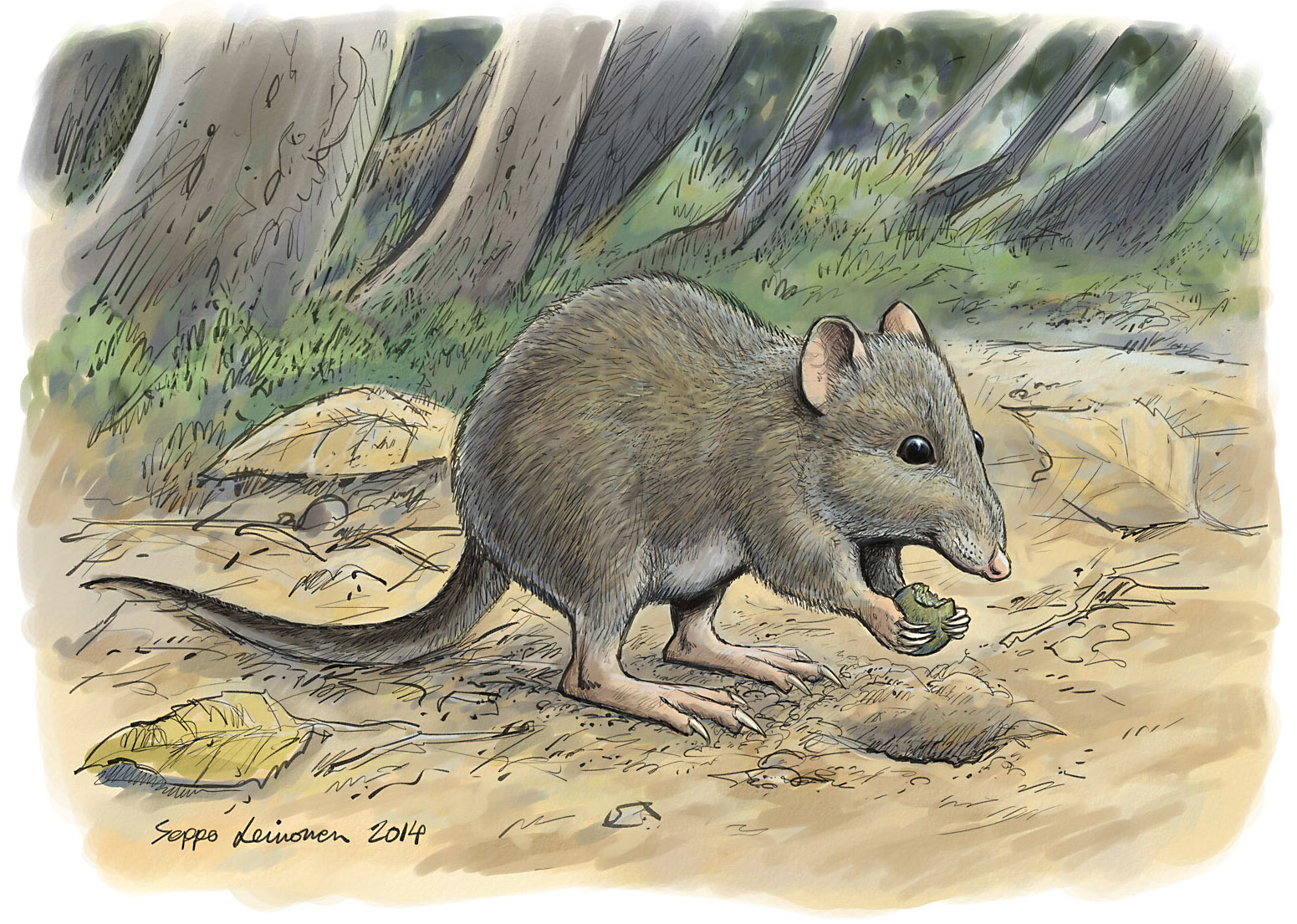(This article was first published in Finnish in Suomen Luonto -magazine 6/2014.)
The Australians are succeeding in a task comparable to that of protecting the Saimaa ringed seal: saving the utterly endangered Gilbert’s potoroo from extinction.

Gilbert´s potoroo is an endemic species in Australia and one of the most endangered mammals in the world. It has been target of ambitious and long-lasting conservation efforts.
Gilbert’s potoroo (Potorous gilbertii) belongs to marsupials and the family of rat kangaroos. It is the most endangered mammal of Australia and one of the most endangered mammals known in the world. This nocturnal animal, which reaches the length of half a meter (including tail) and the weight of appr. one kilo, was already thought extinct until it was found again in 1994 after a pause of 120 years.
A diligent research and conservation work began. The only remaining population of Gilbert’s potoroos at the Two Peoples Bay conservation area was found to include only 30–40 individuals. The survival of the species was threatened by wild cats and dogs, foxes and a disease bothering potoroos. Also a wildfire could have destroyed the last individuals of the species. A couple of fires lit by a lightning near by were just about extinguished.
The researches have had a challenge in tracking the timid Gilberts’ potoroos scampering in the dense bushes. They move around mainly at night and eat truffle like fungi, which they dig off the soil. Like other marsupials they nurture their offspring in pouches.
A group of active citizens founded the Gilbert’s Potoroo Action Group in 2001 (www.potoroo.org). –The citizens’ activity has had an important role in protecting the potoroo, says Dr. Tony Friend, Principal Research Scientist of West Australian Department of Parks and Wildlife and one of the founding members of the action group.
The action group activated schoolchildren in the area to produce brochures and raise money with campaigns. A local winery financed the protection work by selling wine bottles with potoroo-labels. The income was utilized for buying radio transmitters and infra-red cameras used in tracking the potoroos.
Via many kinds of campaigning and publicity work the action group gained sympathy and support from the large audience to this cute but hard-to-see rarity – and later also financing from the environmental ministry.
In order to keep the species alive the researchers founded a new population on the Bald Island of 800 hectares, known to be free of predators, near the coastline. In 2005 the first potoroo pioneers were transported to the island and settled down in their new surroundings. With the help of volunteers the researchers arranged nonstop monitoring of the movements, feeding and weight of these settlers. The first newborn on the island was celebrated towards the end of the year.
Translocating even a couple of individuals from such a scarce population was risky, and therefore the transports were done in ones and twos. Altogether 10 migrants got a helicopter ride to the island, and in five years they grew into a vital population of over 50 individuals. There have been enough potoroos on the Bald Island to be transported to another site as well, a fenced area of 380 hectares in the Waychinicup National Park on the mainland. Since 2009, potoroos have been regularly removed from Bald Island to stock the mainland site.
Dr. Tony Friend presented the protection of Gilberts’ potoroo in an international mammal conference in Belfast in 2013. At the same time he was appointed the responsibility to lead the preparations of the following mammal conference, which was to be held in Australia in 2017.
The species on the Australian continent are mostly endemic, i.e. only found in Australia. The biodiversity of the country has been put through the hoops by invasive species, dams, mines, building and other uses of nature. According to WWF Australia over one hundred species have died out and about 1700 are nationally endangered.
Potoroos
* Potoroos are small Australian marsupials. All three potoroo species are scarce, Gilbert’s potoroo being the smallest and the most endangered.
* Live about 10 years. Give birth to one young at a time and nurture it in the pouch.
* Long hind feet, front feet with claws. Move around hopping like kangaroos, eat with front paws like squirrels.
* Have large eyes as nocturnal animals usually do. Long snout points downward like that of shrews.
Text: Auli Kilpeläinen
Illustration: Seppo Leinonen www.seppo.net/e
- The Invaluable Doñana Wetland Facing Threat of Drought – 2019
- Neonicotinoids – Even PPBs Are Too Much for Insects – 2019
- Ecologists Defend the Invaluable Doñana Wetland – 2018
- European Mink Returns to Estonia – 2016
- Diving for Marine Protected Areas – 2015
- Organic Gardening Inspires Youngsters in Northern Spain – 2015
- Plastic Debris Spoils the Oceans – 2015
- Only Cute and Cuddly Are Worth Conserving? – 2014
- Gilbert´s Potoroo Was Rescued on an Australian Island – 2014







